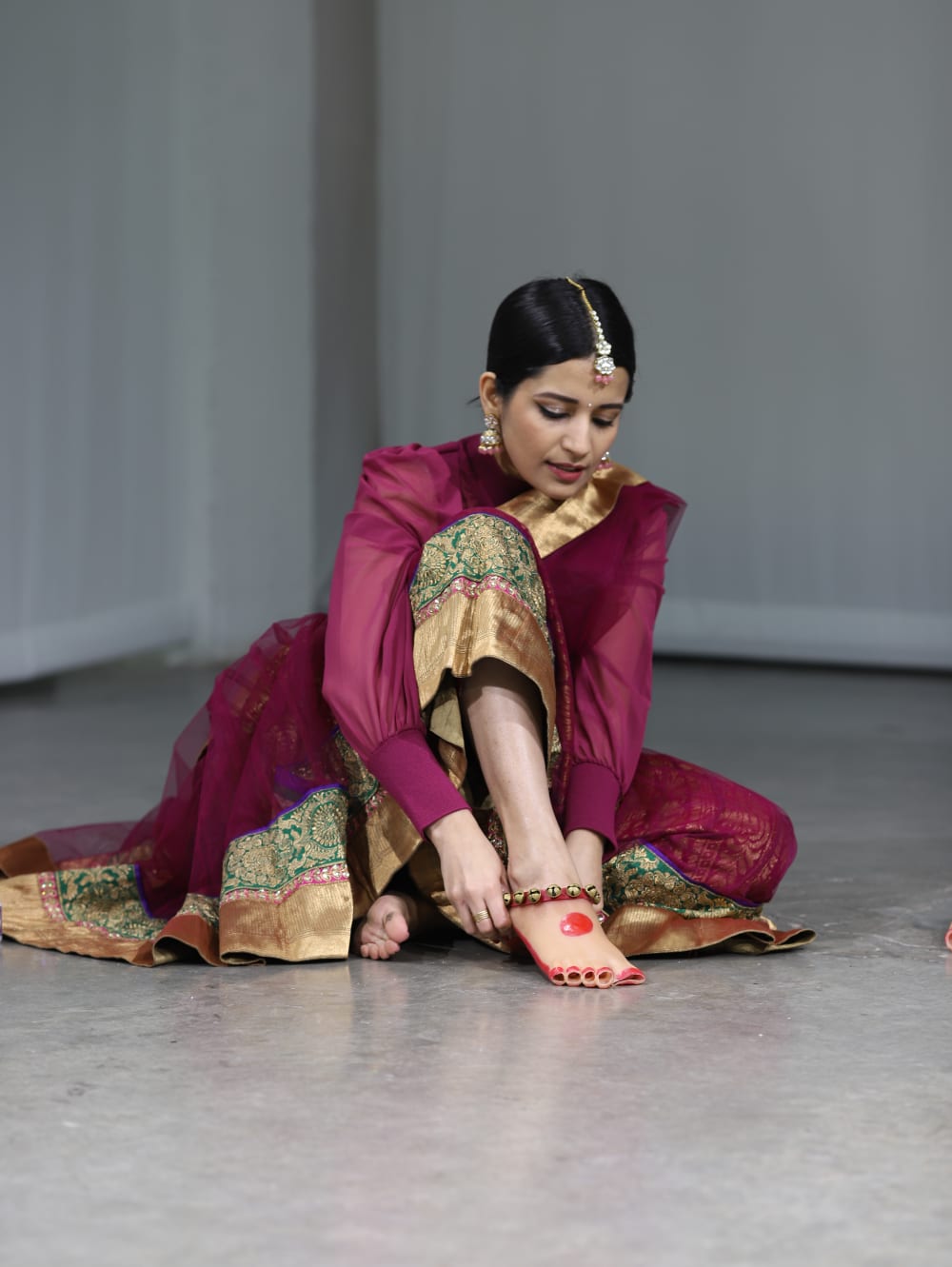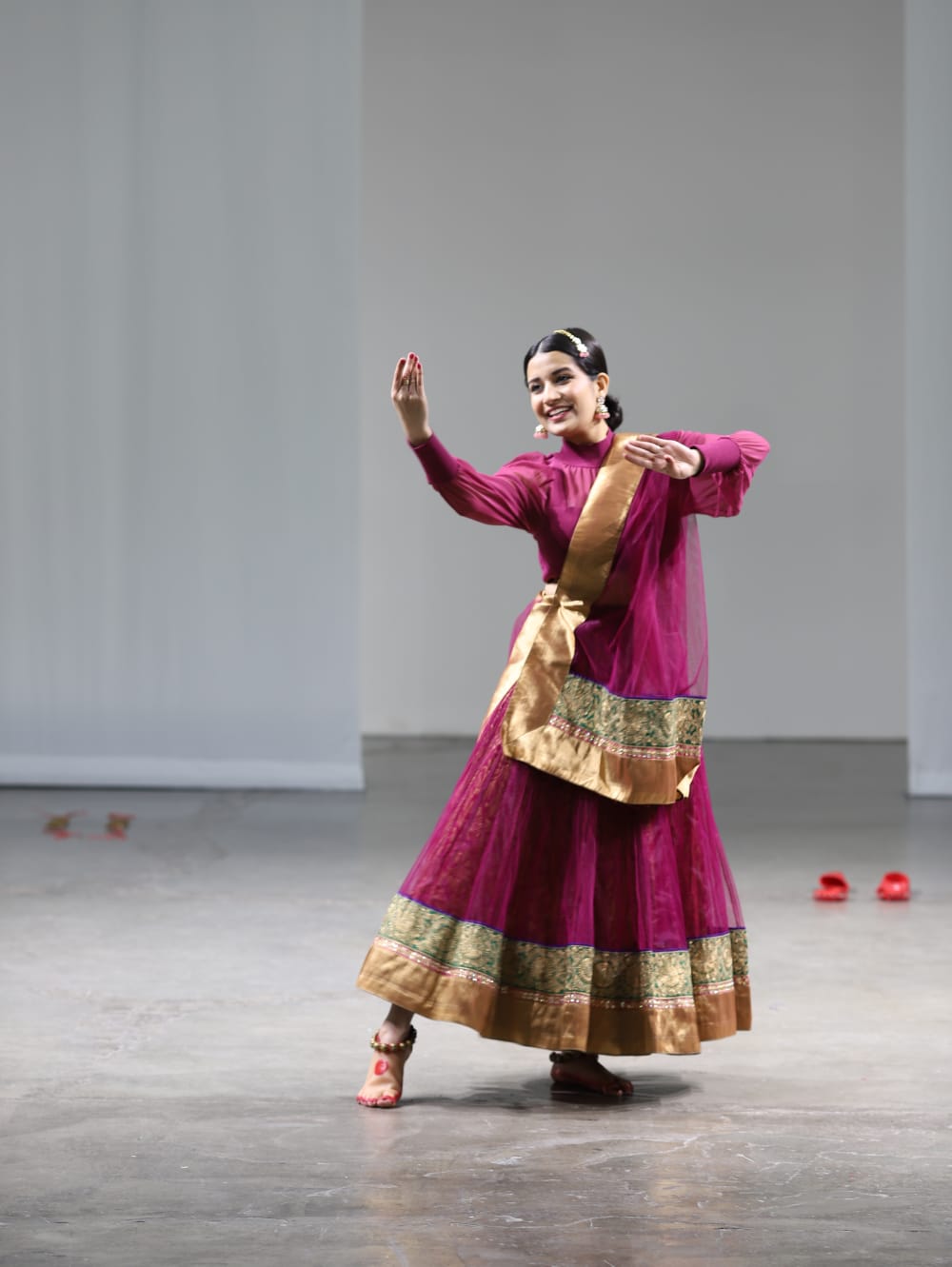
Transforming Indian Classical Dance with Footwear Innovation

- Written byLubna Hussain
- Published date 09 May 2023

We interviewed MA Footwear graduate Aditi Sarna on her final project “Chhaap” by delving into the inspiration and background of her collection of shoes designed to promote healthy feet among Indian classical dancers. The footwear aims to preserve the traditional beauty of the dance while solving a crucial problem of preserving the dancers' feet. We discuss the vision behind the shoes and their origin from the rich history of traditional barefoot dancing in India. The designer also sheds light on the manufacturing process and the materials used in the creation of the shoes, including the incorporation of vibrant, bright red colour and gold ghungroo bells.
Tell us about your final graduate piece Chhaap, where did the name derive from? What story are you trying to tell through the shoes you made?
“Chhaap” is a collection promoting healthy feet among Indian classical dancers by providing them foot coverings for practising or performing the age-old beautiful form of art that is Indian classical dance. The story behind the shoes was pretty straightforward – the ultimate designed footwear should convey the same aesthetics and feel as barefoot dancing but should also solve a much greater purpose of preserving the dancers’ feet without deviating from the traditions.
I wanted the name to do justice to the final pieces and capture the essence of the entire collection and hence “Chhaap” was born. It essentially means an impression or an imprint, thus portraying “an impression through the journey of Indian classical dance”. Since this form is traditionally performed barefoot, introducing such a revolution as foot coverings for performing would undoubtedly leave a significant “Chhaap” in the future of Indian classical dance. The Chhaap logo not only works as a design but also a functional element in the final products as it acts as the sole profile of the shoe which in fact helps in providing grip to the dancers’ feet.

India has a rich history of traditional barefoot dancing that dates back centuries. Please tell us more about this form of dancing and why you decided to base your project around this. Where did it originate from?
The story or the inspiration for this project came from a very personal yet powerful experience. I have grown up seeing my grandmother, mother and myself, perform to the rhythm of the Indian classical dance since a very young age. There are certain traditions that have been formulated centuries ago and these beliefs have been accepted and taught from one generation to the other. Growing up, I began questioning some of the reasons and developed certain reservations about specific notions - The biggest concern being not wearing footwear while dancing. This issue arose because I, myself, have come across situations in the past where dancing barefoot was not only tough but led to serious foot injuries, calluses and friction burns.
After interviewing several Indian classical dancers and reading through articles about the severity of the issue in play, this turned out to be a much bigger global concern. Given the temporary and the more serious long term foot deformities that arise among Indian classical dancers, it was extremely important to take some preventive measures.

Is there a reason behind the incorporation of the use of vibrant bright red colouring with the gold ghungroo bells on the shoes you designed? How many designs did you come up with? Please talk through the different materials, design and manufacturing procedures.
Yes, indeed! There is a notable thought behind the incorporation of these significant elements in the shoes designed. Since my aim was to remain as true to Indian classical dance as possible, I was careful in taking “alta” (red color dye) and “ghungroos” (ankle bells) as my major design elements since these were the only two things that were seen on the Indian classical dancers’ feet while performing.
- The idea behind “Minimal Marvel” was to achieve the look and feel of the ultimate barefoot dancing experience without having to compromise on any traditional aspects. The hyper-realistic look was further intensified by the minute skin detailing and impressions.
- The “All-in-One Alta Socks” portrayed the traditional attire with the dot in the middle and the natural painted alta impression. By giving it an open toe, the nails complement beautifully by simply putting the sock on. This nullified the trouble of prolonged hours to dress the feet before performances.
- The “Innovative Tradition” piece was focused on the unique interpretation of alta as the only part of footwear. While experimenting, it was noticed that the heel and toes were the two major portions in contact with the ground which needed ultimate protection depicted by the bold red colour parts. The ghungroos were fashioned to provide more stability while in motion by a sturdy silicone setting. This resolved the issue of ghungroos hitting and bruising the feet and at the same time giving it an innovative spin on tradition.


Your performance was gorgeous at the LCF23 postgraduate exhibition, how long have you been dancing? What is your personal history of this type of dancing? Is this something you do professionally? Why did you choose to perform in your own designs?
Thank you so much for the appreciation and I am most grateful for having been given the opportunity to showcase on such a prestigious platform. Dancing has always been in my blood since my mother’s side of the family are all amazingly trained dancers. Cannot include my dad for his dancing skills, haha! But all my creativity and inspiration comes from him and his immense support. I might have started dancing before I could even walk but professionally, I began learning a specific form of classical dance called Bharatanatyam at the age of around 7.
Two months into the course, I was diagnosed with a chronic physical condition that started hampering with my course activities. I was blessed to have a supporting UAL family that helped and made the whole process so much simpler. In discussion with my course leader, Mr Eelko, about this project at an initial stage, I had made a statement that always stuck by me till the end. If the vision of these products comes to life and my health improves, I would represent and perform in them myself if and when I get an opportunity to do so. I had therefore manifested this day and to my amazement, made it into a beautiful reality!
Were there any challenges you faced during the production of your collection? If so, how did you overcome them? What research methods did you use to create your masterpieces?
Since the idea was born out of a very personal connection, it was extremely important to critically analyse the gist from the thousands of years old past to the present in order to execute a meaningful future. It was of utmost importance to understand its core from gestures, postures, to material limitations and techniques. The biggest challenge was to preserve the authenticity as the culture and beliefs of this art form are so strong that even the slightest diversion from the roots or the essence was not an option. Therefore, a fine line had to be carefully maintained throughout to achieve such a far-fetched unimaginable concept shaping the future of Indian classical dance.
It was crucial to delve deeper by interviewing and observing from the first-hand experiences of the dancers themselves. Proposing the idea and getting such positive and encouraging feedback was a huge triumph of its own. Every step of the way was so exciting, so inspiring that there was not a moment where it felt dull or mediocre. The entire process was so overwhelming both in a good and a challenging way, as it surpassed from a mere master’s project to a need of the hour invention.


- Find out more about MA Footwear
- Connect with Graduate Futures
- What’s on at LCF: open days and events
- More LCF Stories